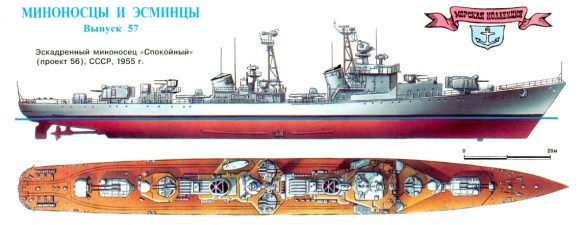Project 56 – Kotlin-class was considered as the VMF’s first true post-war destroyer.
For the ten-year programme the Navy had wanted to get 118 big and 70 normal destroyers, but Stalin had – as mentioned – blocked the building of the big destroyer designs and forced concentration on to the proven projekt 30, including easy-to-get improvements for a fast mass series production of about 250 units. This improved design for a projekt 30-bis destroyer was started on 8 October 1945. Based on projekt 30K the chief constructor of TsKB-53, A.L. Fisher, produced a design which was approved on 28 January 1947. The first 20 orders were placed on 3 December 1947, and the building of the lead ship, the Smelyi, began on 16 May 1948 at the Zhdanov yard/No. 190 at Leningrad and was completed on 21 December 1949. Up to February 1953 yard No. 190 built 16 units, the yards No. 402 at Molotovsk, No. 445 at Nikolaev, and No. 199 at Komsomol’sk 18 each, 70 vessels in all, the biggest surface ship series built in the Soviet Union.
A problem was the inclusion of big destroyers, so much asked for by Kuznetsov, into the programme. There were three possible designs, first the upgraded destroyer leaders of projekt 48K, of which two uncompleted vessels, the Kiev and Erevan, were still at Nikolaev. The second possibility was the projekt 40, favoured by Kuznetsov for the Pacific, designed in two versions by the TsKB-17, one with a forecastle and one with a flush deck, and projekt 41, also a flush decker but with only two twin 130mm dual mounts instead of the three of projekt 40, designed by V A. Nikitin of TsKB-53. But projekt 48Kwas cancelled for being out of date, and projekt 40 as it was too big for mass production. So only projekt 41 remained, which introduced a great number of innovations for Soviet shipbuilding, such as the pressure-fired steam plant, dual-purpose 130mm main guns and a completely welded hull, and a maximum reduction of structures above the weather deck. The TTZ was accepted on 14June 1947 and the technical design approved on 28 September 1949. The lead ship, the Neustrashimyi, was laid down on 5 July 1950 at the Zhdanov yard No. 190, and launched already on 29 January 1951. But difficulties with the tests, especially the insufficient speed reached, delayed commissioning until 31 January 1955. Despite the fact that in December 1950 four more vessels were laid down at the yards No. 190 and No. 402, the project was cancelled in favour of a smaller projekt 56 with many of the improvements of projekt 41 included. Only the Neustrashitnyi was commissioned, and the others were scrapped on the slips.
When the problems With projekt 41 became obvious, on 2 June 1951 an order ‘to change the military characteristics of projekt 41’ was issued, and the TsKB-53 with A.L. Fisher worked out the design for a projekt 56 series destroyer of reduced size, but with most of the armament of projekt 41 and a speed of 38kt. A production run of 100 vessels was envisaged, and the prefabrication of parts of the first two ships had been started already in February 1952, with the first six ships being laid down at the Zhdanov yard No. 190, three more at the Marti yard No. 445 at Nikolaev and two at the yard No. 199 at Komsomol’sk, before the TTZ was finally approved on 4 April 1954. In all, 27 vessels were built and completed to the original design, but in October 1955 the building was stopped and the other four ships, for which the material had been prepared, were redesigned as missile ships, to be noted later. It is said that these ships were very well liked in the Soviet Navy.
